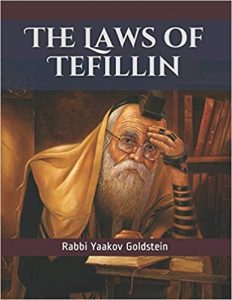*As an Amazon Associate I earn from qualifying purchases.
Verifying the Kashrus of the squareness of the sewing of your Batim:[1]
Background of the law of squareness:[2] It is a Halacha from Moshe on Sinai that the Tefillin must be square. This applies to both the head and arm Tefillin. This applies also to the sewing of the Batim which holds the Titura closed, that it must be an exact square [both on top and bottom[3]], which means that the length of the sewing must be equal to the width of the sewing.[4] [So long as the area appears like a perfect square to the naked eye, then it is considered valid, even if under measurement of a rule, the dimensions are not exactly equal.[5]] If this area of the Tefillin is not square, it is invalid.[6] [Nevertheless, some Poskim[7] rule that if no other Tefillin are available then they are to be worn without a blessing.]
Verifying the squareness: It occurs at times that the squareness of the Tefillin becomes damaged due to contact with a hard object, and other forms of impact. While this damage can certainly affect the Kashrus status of the Tefillin [depending on the level of damage done], there is a much more prevalent “squareness destroyer” which can deem the Tefillin invalid which takes place right under the Tefillin, and that is moisture and sweat. Moisture of one’s hair, whether due to sweat or showering, penetrates the Tefillin’s leather and with time begins to expand it. Eventually this can cause the squareness of the sewn area on the bottom of the Tefillin to lose shape and become invalid. While many are aware of the requirement for the actual Bayis to be square, many are unaware of the requirement for the sewed areas to also be square, and if this squareness is damaged, the Tefillin are invalid. Thus, one is to be very careful not to wear Tefillin with wet hair, at least not on a consistent basis, and one should also periodically look at the bottom of his Tefillin to verify that the sewing’s squareness has not been altered. One who sweats a lot on his way to Shul should preferably use a towel to dry his hair prior to putting on his Tefillin. If one sees any alteration that has taken place, it is to be brought to a Rav who is expert in Stam for checking.
______________________________________________________________________________[1] See Inside Stam p. 286
[2] Admur 32:59; Michaber 32:39; Mordechai Hilchos Tefillin; Rambam Tefillin 3:1; Braisa Menachos 35a; See Biur Halacha 32:39 “Sheyiyu”; Piskeiy Teshuvos 32:60 in footnotes; 62-64
[3] M”B 32:174 although he concludes with a Tzaruch Iyun regarding Bedieved
[4] Admur ibid; Michaber ibid; Rav Papa ibid as explains Rosh [unlike Rashi]; See P”M 32 M”Z 33; Kol Yaakov 32:175; Biur Halacha ibid
[5] Elya Raba 32:59 “As much as humanly possible, as its impossible to make an exact square.”; Madanei Yom Tov on Rosh; Maharsham 8:16; Peri Hasadeh 3:189; Os Chaim Veshalom 32:15; Eretz Tzevi 1:12; Igros Moshe 3:120; Mishneh Halachos 1:34; Piskeiy Teshuvos 32:62
[6] Admur ibid; Rambam Tefillin 3, brought in M”B 32:173
Other opinions: Some Poskim rule that if the Tefillin are not square they nevertheless sremain Kosher. [See Biur Halacha 32:39 “Sheyiyu” in name of Rashi]
[7] M”B 32:173; Biur Halacha 32:39 “Sheyihyu” in name of Yeshuos Yaakov; SeeShevet Halevi3:2 that if the Tefillin are invalid according to all, then they are not to be worn at all



Leave A Comment?
You must be logged in to post a comment.